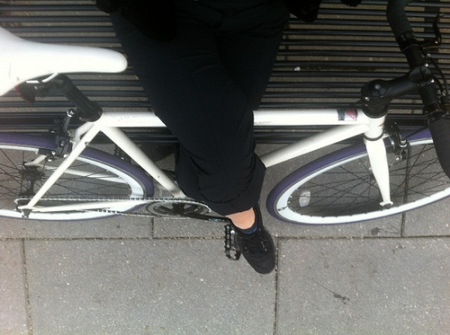
The New York Times has a nice discussion of an article just published in the Journal of Physiology, “An investigation into the relationship between age and physiological function in highly active older adults” (full article available at the journal’s page).
This study looked at a mix of laboratory and other “internal” tests, performance tests (lung function, exercise), reflexes, balance, and memory in active cyclists, 55 to 79 years old. Almost all of them had been cycling for around 20 years or longer. They wanted a good picture of healthy, long-term active older people that they could compare to age-based averages. These people didn’t compete in races, but they were riding about 300 to 500 miles a month (probably around 5 to 10 hours a week) — compatible with a normal lifestyle but maybe resulting in a grumpy spouse who wants more participation at home. (Marry a fellow cyclist, folks!)
We can look at someone and guess about how old they are, but there is a ton of variation in how bodies perform at different ages. The lab tests don’t really tell the story, and although we’ve tended to assume that people decline with age, we haven’t teased out the genetics and lifestyle factors yet. They did see some age-related changes in power production and muscle mass, as has been demonstrated in other populations (including competitive athletes), but in general pretty much no difference in most of the stuff we think of as deteriorating inevitably with age. They concluded that the physical signs they were seeing had more to do with activity level than number of years people had been alive.
“If you gave this dataset to a clinician and asked him to predict the age [of one of the cyclists based on his or her test results],” Dr. Harridge said, “it would be impossible.” On paper, they all look young.
(Interestingly, clinicians have assumed in the past that a threshold of muscle mass reduction termed “sarcopenia” results in increased frailty in the aged — an important risk factor for serious injury from falls, for example. Several participants had sarcopenia without any signs of frailty. Frailty is, of course, an issue for older people, but it may be that what we think of “sarcopenia” is just something that slim, athletic older people might have, with little clinical importance.)
This study was done in only 125 people, but the results are so consistent in the group that it almost certainly shows real effects of being active (or real non-effects of just plain getting older). The authors plan to keep following up with their study subjects. In meantime, we should all keep moving.
Photo by me: I stayed at a hotel in Philadelphia that offered these slick single-speed bikes to guests — perfect for a couple dozen miles on a nearby bike trail!
